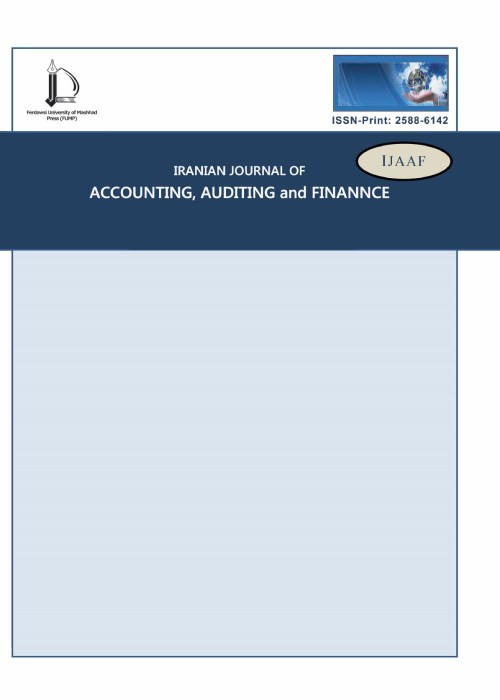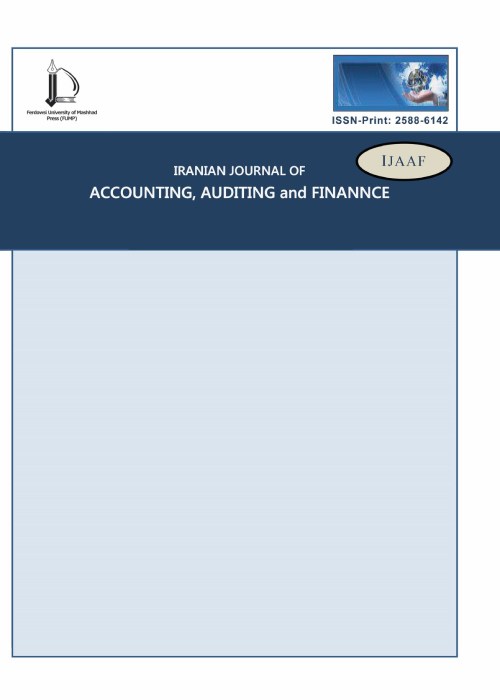فهرست مطالب

Iranian Journal of Accounting, Auditing and Finance
Volume:7 Issue: 2, Spring 2023
- تاریخ انتشار: 1402/02/25
- تعداد عناوین: 7
-
-
Pages 1-16
Profitability and risk indicators are considered factors for evaluating financial and banking systems. A bank is considered stronger than another if it is stable and capable of absorbing risks. This research aims to investigate the influence of factors affecting the risk and profitability of banks, emphasizing the role of government credits. The study's statistical population is all banks in the central bank’s database between 2005 and 2019. In this study, to investigate the factors affecting profitability in the banking industry of the Organization of Islamic Cooperation, the emphasis was on the role of government credit. The Generalized Method of Moments System (GMM-SYS) was used. The results show that while previous government loans and credits have a negative and significant effect on banks’ profitability, current government loans and credits have a positive and significant effect on risk. The high level of government loans and credits, as an indicator of financial development, and the high level of domestic investment, indicate the development of a country’s financial systems. In countries where the financial system emphasizes public sector payments, transaction costs, risk control and management, and savings mobility are higher than in other countries. Specifically, the highest rates are in high-income countries, indicating the role of banks in the financial markets of those countries.
Keywords: profitability, Risk Management, Banking System, Government Credits -
Pages 17-37This research aims to investigate the impact of the geographical proximity of institutional owners on corporate social responsibility (CSR) disclosure while considering the moderating role of corporate governance mechanisms. The study examines 105 companies listed on the Tehran Stock Exchange between 2014 and 2020, using financial statements and independent auditor's reports as primary data sources. It adopts a correlational research design, categorizing it as descriptive and post-event due to its longitudinal time horizon and use of historical information. Findings suggest that ownership of local institutional owners alone does not significantly influence CSR disclosure. However, research and development expenditures and the independence and expertise of the audit committee moderate the relationship between the geographical proximity of institutional owners and CSR disclosure. Notably, companies with higher R&D expenditures and independent and specialized audit committees disclose more CSR information with increasing ownership of local institutional owners. Conversely, board independence, audit firm type, and CEO/chairman duality do not significantly affect this relationship. This study is innovative, as no previous research has explored the connection between the geographical proximity of institutional owners and CSR disclosure.Keywords: Geographical proximity of institutional owners, corporate governance, social responsibility
-
Pages 39-60
The current research investigates the top 30 companies of the Tehran Stock Exchange from 2009 to 2021, looking at each quarter. In this study, the traditional stop-loss (SL1) and trailing stop-loss (SL2) methods were used to calculate the stop-loss and buy-and-hold strategies to compare their trading effectiveness. The return variable was calculated separately for the first, second, and third months and all three were used together. To investigate the relationship between variables, EViews and SPSS software was used. The variables were subjected to significant and descriptive statistical analysis. The Paired Simple Test results showed that the Trailing Stop-loss (SL2) strategy had a higher return than the other two strategies during the three months. The Wilcoxon nonparametric and Sign tests' results confirmed that the Stop-Loss strategy (SL2) performed better than others. Time series tests such as the Unit Root, Self-correlation, Momentum Behaviour, and Variance Heterogeneity tests were accomplished to investigate the correlation between returns. In brief, the results showed that the Trailing Stop-loss (SL2) strategy functioned better than the other two strategies on the Iranian Stock Exchange. This finding can help investors decide among different strategies to profit more on the Tehran Stock Exchange.
Keywords: Investment, Return, Technical analysis, Stop-loss Strategy, Buy, Hold Strategy -
Pages 61-81This paper aims to determine the relationships, the portion, and the amount of influence of each contributing factor to audit quality and propose a model for audit quality based on spirituality and the moral atmosphere in Iran. This paper is practical in terms of objective and mixed-method. The statistical population comprises the employed auditors in firms and audit organizations, among whom a sample of 313 participants is selected. The structural equation modelling by the SMART PLS method and the ratio test is used for data analysis. The obtained results show that personal dimensions, including (character, motivation, and piety); organizational dimensions (sociability and organizational commitment); psychological dimensions (spirituality in the workplace, moral atmosphere of the organization, psychological health of the workplace, job satisfaction, and personality type), and leadership dimensions (leadership style, spiritual leadership) have the highest impact on the audit quality based on spirituality and moral atmosphere in the Iranian workplace respectively. In this paper, in contrast to the previous studies that took into account the quantitative contributing factors to audit quality, the focus is on the qualitative factors based on spirituality and moral atmosphere. In this regard, by implementing and enhancing the workplace's spiritual and moral atmosphere, we can elevate the audit quality and minimize inappropriate functions of the auditor. Moreover, the study results can guide policymakers in Iran and other countries with similar organizational milieu for future supervisory amendments.Keywords: Audit Quality, Spirituality, moral Atmosphere, Smart Pls Method
-
Pages 83-98
Encrypted assets can be traded like traditional currencies, and products and services can be exchanged for digital currencies. The use of SMART contracts in the context of the blockchain network allows startups to be able to finance creative projects. In this research, a qualitative-quantitative approach has been used. Meta-synthesis method was used to identify smart financing indicators for startup businesses. In the quantitative stage, the importance of the extracted indicators was collected by distributing questionnaires among 220 investors and the project team and analyzed with the help of SPSS software and One-Sample T-tests, and Friedman's ranking. The results showed that among the 7 indicators of the intelligent model extracted from the qualitative method, the indicators of implementation, trust, and results are considered the most critical dimensions from the respondents' point of view in intelligent financing. Also, the indicators of confidence, participation, and cognition are next in importance, and the belief index was ranked seventh. The proposed model covers 78% and 80% of the opinions of the investors and the project team. Among the advantages of the proposed model are fast, safe, and transparent financing, diversity in investment method choices, project interaction, SMART contracts, and a pattern of reward distribution to network members instead of transaction fees. A blockchain-based financing model can provide startups with a quick and low-cost path to growth and development.
Keywords: Encrypted assets, SMART financing, HamiChain, Startup -
Pages 99-110Before the Finance Act 2019, multinationals exploited the absence of thin capitalization rule in Nigeria, resulting in the government's loss of tax revenue. Thereby necessitating the examination of the effects of thin capitalization on the financial performance of multinational firms in Nigeria. Secondary data was obtained from the annual reports of eight selected multinationals from 2014 to 2021. Thin capitalization was a proxy with financial leverage ratio, fixed-charge coverage ratio and debt ratio; financial performance was a proxy with return on asset, while the firm’s size was used as a control variable. Data were analyzed using descriptive statistics, cross-sectional dependence tests, serial correlation, normality tests and regression analyses. The findings revealed that financial leverage and debt ratio do not significantly affect ROA, while fixed-charge coverage ratio had an effect on ROA. The study, therefore, concluded that thin capitalization does not affect multinationals in Nigeria. Hence, Federal inland revenue was recommended to ensure that all multinationals comply with the Finance Act 2019 on the restriction of interest deductible from profit.Keywords: Leverage Ratio, Fixed-charge coverage ratio, Debt ratio, Multinational firms
-
Pages 111-124IFRS 9 changes the bank’s impairment accounting for debt instruments by replacing the incurred credit loss model with a forward-looking expected credit loss (ECL) model. This study examines the challenges of switching to the ECL model in the Iranian banking industry. We designed a questionnaire with 46 questions and sent them to four groups include: "banks", "bank auditors", "regulatory bodies" and "academic experts and researchers". The questionnaire’s rate of return was 90% and data were analyzed using fuzzy logic. We find that factors such as the prolonged judicial process of receiving receivables, related parties or political cronies, obligations imposed by the government, inefficiency of risk management and etcetera have caused banks to have a large volume of non-performing loans (NPLs). Failure to solve these problems will cause the ECL model not to be implemented properly. Also, according to our findings implementing this model will majorly change how Iranian banks manage and report their credit risks and reserves. The successful implementation of an ECL approach for impairment accounting will heavily depend on providing the necessary infrastructures at the macro level, supervision, and banks. It seems to require a relatively long time and careful planning to implement the ECL approach according to the current situation and infrastructures.Keywords: IFRS 9, Expected Credit Loss (ECL), Challenges, obstacles, Iranian banking industry


